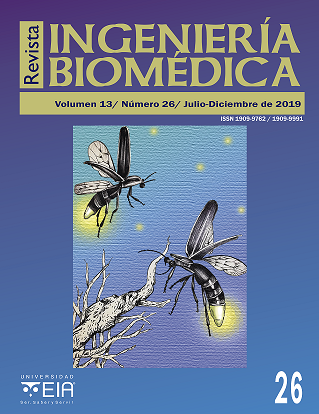Comparative study of methods for the frequency recognition of Steady state visual evoked potentials on experienced and naive users on Brain-Computer Interface
Estudio comparativo de métodos para el reconocimiento frecuencial de potenciales evocados visuales en estado estacionario en usuarios con y sin experiencia en Interfaces Cerebro-Computador

Show authors biography
One of the advantages reported in the literature about of Steady State Visual Evoked Potentials (SSVEP) over other paradigms for use in a Brain-Computer Interface (BCI) is that it is possible to obtain an adequate classification of commands in users without BCI experience (naives). The present article focuses on quantifying the variation in the performance of a BCI-SSVEP for users with experience (group 1) and without experience (group 2). Two of the state-of-the-art methods for SSVEP recognition were used: Canonical Correlation Analysis (CCA) and Canonical Correlation Analysis using Filter Bank (FBCCA). For this study, a database referenced in other studies (benchmark) is used, it is composed of 40 different visual stimuli, the analysis was performed with 16 subjects (8 each group). Classification Percentage and ITR were used as rating metrics to evaluate the performance of methods, were evaluated in 4-time windows: 0.5 s, 1 s, 1.5 s and 2 s. In addition, a statistical significance analysis was performed. As result, it was obtained that the best SSVEP recognition method correspond to the FBCCA with average percentage of classification of 93.31% for group 1 and 89.22% for group 2, and ITR of 169.85 bits/minute for group 1 and 142.76 bits/minute for group 2, in this last case evaluated in a time window of 1.5 s. Finally, the statistical analysis with a significance of 5%, allows to conclude that the experience in BCI has a low influence on the performance of a BCI-SSVEP system.
Article visits 811 | PDF visits 420
Downloads
- M.Chan, Organización Mundial de la Salud (OMS) (2011). Consultado el 7 de octubre de 2019 en: https://www.who.int/disabilities/world_report/2011/es/.
- J. Gómez, Departamento Administrativo Nacional de Estadística (DANE) (2008). Consultado el 7 de octubre de 2019 en: https://www.dane.gov.co/index.php/estadisticas-por-tema/demografia-y-poblacion/discapacidad.
- J. R. Wolpaw, N. Birbaumer, D. J. McFarland, G. Pfurtscheller, T. M. Vaughan, "Brain-computer interfaces for communication and control", Clin. Neurophysiol., vol. 113, pp. 767-791, Junio 2002.
- J.Becedas, “Brain Machine Interfaces: basic and advances”, IEEE Transactions on system, man and cybernetics, vol 42, pp 825-836, 2012.
- J.Boelts, A.Cerquera, A.Ruiz, “Decoding of imaginary motor movements of fists applying spatial filtering in a BCI simulated application”, International Work-conference on the interplay between natural and artificial computation, Elche, España, 2015.
- G. Baura, Medical device technologies: a system-based overview using engineering standars, Academic Press, 2011, Capítulo 13, 280-283.
- N. Inkaew, N. Charoenkitkamjorn, C. Yangpaiboon, M. Phothisonothai, C.Nuthon, “Frequency component analysis of EEG recording on various visual tasks: Steady-state visual evoked potential experiment”, International conference on knowledge and smart technology (KST), Chonburi, Tailandia, Enero 2015.
- Y. J. Wang, R. P. Wang, X. R. Gao, B. Hong, S. K. Gao, "A practical VEP-based brain-computer interface", IEEE Trans. Neural Syst. Rehabil. Eng., vol. 14, pp. 234-239, 2006.
- D.Zhu, J.Bieger, G. García, R.Aarts, “A survey of stimulation methods used in SSVEP-Based BCIs”, Computational Intelligence and Neuroscience, vol 2010, pp 1-12, 2010.
- Q.Wei, M. Xiao, Z.Lu, “A comparative study of canonical correlation analysis and power spectral density analysis for SSVEP detection”, Third international conference on intelligent human-machine systems and cybernetics, Zhejiang, China, Agosto 2011.
- R. Wang, W. Wu, K. Iramina, S. Ge, “The combination of CCA and PSDA detection methods in a SSVEP-BCI system”, 11th World congress on intelligent control and automation, Shenyang, China, Julio 2014.
- G. Hakvoort, B. Reuderink, M. Obbink, Comparison of PSDA and CCA detection methods in a SSVEP-based BCI-system Technical Report TR-CTIT-11-03, 2011.
- L. Meng, J.Lin, X.Wang, “A comparison of navigation system based on P300 BCI and SSVEP BCI”, 24th Chinese Control and Decision Conference (CCDC), Taiyuan, China, Mayo 2012.
- C.Liu, S.Xie, X.Xie, X.Duan, W.Wang , K. Obermayer, “Design of a video feedback SSVEP-BCI system for car control based on improved MUSIC method”, 6th International conference on Brain-Computer Interface (BCI), GangWon, Corea del Sur, Enero 2018.
- N.Gao, W.Zhai, J.Lu, S.Lu, Y.Tian, “Intelligent wheelchair research based on SSVEP brain-computer interface”, International Conference on Biological Information and Biomedical Engineering, Shangai, China, Junio 2018.
- M.H.Lee, O-Y.Kwon, Y-J.Kim, H-K.Kim, Y-E.Lee, J.Williamson, S.Fazli y S-W.Lee, ”EEG dataset and openBMI toolbox for three BCI paradigms: an investigation into BCI illiteracy”, GigaScience , No 8, pp 1-16, Enero 2019.
- G. Hakvoort, B. Reuderink, M. Obbink, Comparison of PSDA and CCA detection methods in a SSVEP-based BCI-system Technical Report TR-CTIT-11-03, 2011.




